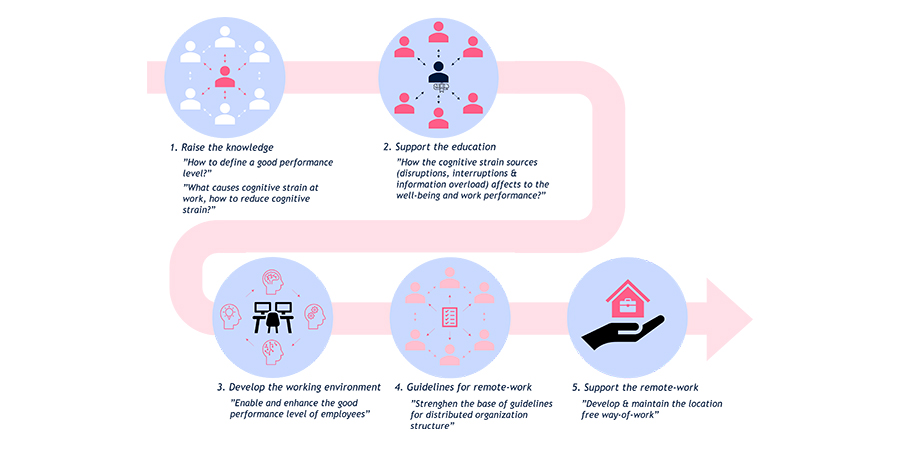Five steps for the transformation towards cognitively sustainable work life
In the last blog post, I wrote about the importance of cognitive ergonomics in knowledge-based work and the negative impacts of cognitive strain such as lower task performance and increased anxiety.
In this blog post, I will present five steps for employees and organizations on how to transform towards a cognitively sustainable working environment.
1. Raise the knowledge
The first step towards a cognitively sustainable work life is building the foundation and raising awareness of cognitive ergonomics in the organization. What is knowledge work? What causes cognitive strain? How can we reduce it?
2. Support the education
Next comes education. Offer the possibility for everyone in the organization to educate themselves about cognitive ergonomics and cognitive strain in more detail.
By identifying cognitive strain sources, the employee has better information on what affects their well-being and work performance. This helps them take control of their work, prioritize task lists, schedule weekly plans, and utilize their calendars. Planning works this way gives room to cognitively recover within every workday.
3. Develop the working environment
Focusing on the physical and virtual working environment in the organization is the third step. Developing office environment space and practices with for example lay-out planning and commonly agreed silent hours support cognitive ergonomics.
4. Guidelines for remote work
Fourth comes creating guidelines for distributed organization structure and remote work. When and how to contact each other, and when not? How to book calendar slots from each other?
5. Support remote work
Finally comes supporting location-free way of work for the employees, who are willing to conduct their work from the home offices. For example, you can support employees to build their workstations at home.
Towards cognitively sustainable work life
Cognitive ergonomics is a key factor in the success of knowledge-intense organizations, as daily work requires an ability to focus with a minimum amount of possible cognitive strain sources. Employees know this as well: based on my interview results, the respondents preferred cognitively ergonomic environment over physically ergonomic environment, especially in times of larger workloads and cognitive strain.
By discussing and gaining information from knowledge workers and learning from it, we can shape modern work life toward a cognitively sustainable direction. This is a push that the work-life will be happy for!

A roadmap for cognitively sustainable organization
References
- Costas, J., & Kärreman, D. (2016). The bored self in knowledge work. Human Relations, 69(1), 61-83.
- Kalakoski, V. (2019). Cognitive Ergonomics is a Matter of Cognitive Factors. In ReCogErg@ ECCC (pp. 46-51).
- Paajanen, T. & Kalakoski, V. (2017). Mitä työterveyslääkärin tulisi tietää kognitiivisesta ergonomiasta? Työterveyslääkäri-lehti 35 (2), 16-21.
- Pyöriä, P. (2005). The concept of knowledge work revisited. Journal of knowledge management. 9 (3), 116-127.
- Työterveyslaitos. Kokonaisvaltainen ergonomia.
This blog is based on the final thesis for the writer’s MBA studies in University of Vaasa. Huld is a highly knowledge-intensive organization, and it matched well for the thesis topic which encouraged Juho to execute the research for Huld.
